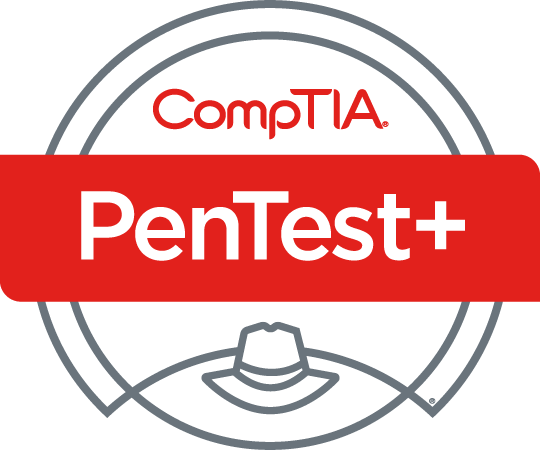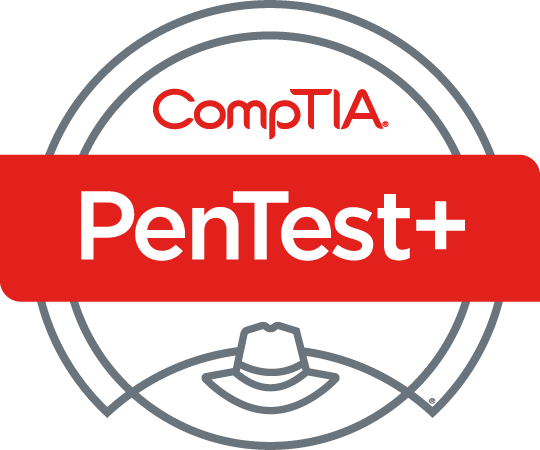

Modules
1 -
Introduction

#
Lesson
Duration
Type
1.
Introduction
12m:23s
 Video
Video
2.
Download your free study guide
 PDF
PDF
3.
Exam Tips
4m:14s
 Video
Video
4.
How to Use the Lab Environment
5m:27s
 Video
Video
5.
Labs: Exploring the PenTest+ Lab Environment
 Lab
Lab
6.
100% Pass Guarantee
3m:49s
 Video
Video
7.
Checkpoint: Introduction
 Quiz
Quiz
2 -
PenTesting Overview

#
Lesson
Duration
Type
1.
PenTesting Overview
2m:54s
 Video
Video
2.
Planning the Engagement
4m:23s
 Video
Video
3.
Information Gathering
4m:2s
 Video
Video
4.
Attacks and Exploits
3m:29s
 Video
Video
5.
Post-Exploitation
3m:4s
 Video
Video
6.
Reporting
3m:47s
 Video
Video
7.
Overview of a PenTest
9m:18s
 Video
Video
8.
Checkpoint: PenTesting Overview
 Quiz
Quiz
3 -
Pre-Engagement Activities

#
Lesson
Duration
Type
1.
Pre-Engagement Activities
3m:20s
 Video
Video
2.
Regulations and Standards
6m:24s
 Video
Video
3.
Types of Assessments
4m:32s
 Video
Video
4.
Types of Agreements
4m:17s
 Video
Video
5.
Legal and Ethical Considerations
4m:31s
 Video
Video
6.
Rules of Engagement
4m:48s
 Video
Video
7.
Target Selection
4m:54s
 Video
Video
8.
Shared Responsibility Model
4m:23s
 Video
Video
9.
Preparing to PenTest a Cloud Provider
4m:13s
 Video
Video
10.
Checkpoint: Pre-Engagement Activities
 Quiz
Quiz
4 -
Frameworks

#
Lesson
Duration
Type
1.
Frameworks
3m:43s
 Video
Video
2.
MITRE ATT&CK
4m:54s
 Video
Video
3.
OWASP
4m:55s
 Video
Video
4.
MASVS
4m:14s
 Video
Video
5.
PTES
5m:22s
 Video
Video
6.
CREST
3m:54s
 Video
Video
7.
OSSTMM
3m:8s
 Video
Video
8.
STRIDE
5m:41s
 Video
Video
9.
Purdue Model
3m:55s
 Video
Video
10.
OCTAVE
6m:53s
 Video
Video
11.
DREAD
5m:9s
 Video
Video
12.
Using the MITRE ATT&CK Framework
4m:33s
 Video
Video
13.
Checkpoint: Frameworks
 Quiz
Quiz
5 -
Information Gathering

#
Lesson
Duration
Type
1.
Information Gathering
3m:9s
 Video
Video
2.
Passive Reconnaissance
3m:30s
 Video
Video
3.
Network Sniffing
5m:10s
 Video
Video
4.
Active Reconnaissance
3m:47s
 Video
Video
5.
Port and Protocol Scanning
5m:51s
 Video
Video
6.
HTML Scraping and Cached Pages
2m:59s
 Video
Video
7.
Banner Grabbing
5m:2s
 Video
Video
8.
Conducting Banner Grabbing
3m:45s
 Video
Video
9.
Checkpoint: Information Gathering
 Quiz
Quiz
6 -
Open-Source Intelligence (OSINT)

#
Lesson
Duration
Type
1.
Open-Source Intelligence (OSINT)
2m:48s
 Video
Video
2.
Social Media and Job Boards
4m:45s
 Video
Video
3.
Information Disclosures
4m:8s
 Video
Video
4.
Cryptographic Flaws
6m:31s
 Video
Video
5.
DNS Lookups
7m:40s
 Video
Video
6.
Certificate Transparency Logs
4m:50s
 Video
Video
7.
Search Engine Analysis
4m:27s
 Video
Video
8.
Conducting OSINT
10m:35s
 Video
Video
9.
Checkpoint: Open-Source Intelligence (OSINT)
 Quiz
Quiz
7 -
Scanning and Enumeration

#
Lesson
Duration
Type
1.
Scanning and Enumeration
3m:56s
 Video
Video
2.
OS and Service Discovery
14m:58s
 Video
Video
3.
Enumerating Protocols
4m:52s
 Video
Video
4.
Enumerating DNS
3m:56s
 Video
Video
5.
Enumerating Directories
5m:1s
 Video
Video
6.
Enumerating Hosts
6m:44s
 Video
Video
7.
Enumerating Users
2m:45s
 Video
Video
8.
Enumerating Email
3m:17s
 Video
Video
9.
Enumerating Permissions
4m:57s
 Video
Video
10.
Enumerating Wireless Devices
4m:27s
 Video
Video
11.
Enumerating Secrets
4m:53s
 Video
Video
12.
Enumerating the Web
4m:38s
 Video
Video
13.
Attack Path Mapping
3m:22s
 Video
Video
14.
Checkpoint: Scanning and Enumeration
 Quiz
Quiz
8 -
Recon and Enumeration Tools

#
Lesson
Duration
Type
1.
Reconnaissance and Enumeration Tools
3m:36s
 Video
Video
2.
Wayback Machine
2m:46s
 Video
Video
3.
theHarvester and Hunter.io
4m:54s
 Video
Video
4.
OSINT Tools
4m:5s
 Video
Video
5.
Whois and recon-ng
20m:32s
 Video
Video
6.
nslookup and dig
6m:58s
 Video
Video
7.
DNSdumpster and Amass
6m:30s
 Video
Video
8.
Shodan and Censys.io
5m:42s
 Video
Video
9.
tcpdump
5m:31s
 Video
Video
10.
Wireshark
5m:42s
 Video
Video
11.
Wireless Analysis Tools
5m:12s
 Video
Video
12.
Checkpoint: Recon and Enumeration Tools
 Quiz
Quiz
9 -
Nmap and NSE

#
Lesson
Duration
Type
1.
Nmap and NSE
2m:34s
 Video
Video
2.
Nmap Discovery Scans
7m:54s
 Video
Video
3.
Nmap Port Scans
9m:13s
 Video
Video
4.
Nmap Fingerprinting
4m:13s
 Video
Video
5.
Using Nmap
11m:31s
 Video
Video
6.
Nmap Scripting Engine
7m:0s
 Video
Video
7.
Checkpoint: Nmap and NSE
 Quiz
Quiz
10 -
Scripting Basics

#
Lesson
Duration
Type
1.
Scripting Basics
2m:11s
 Video
Video
2.
Shells and Programming Languages
9m:48s
 Video
Video
3.
Variables
7m:52s
 Video
Video
4.
Loops
5m:20s
 Video
Video
5.
Logic Control
4m:33s
 Video
Video
6.
Data Structures
12m:37s
 Video
Video
7.
Object Oriented Programming
6m:58s
 Video
Video
8.
Checkpoint: Scripting Basics
 Quiz
Quiz
11 -
Modifying Scripts

#
Lesson
Duration
Type
1.
Modifying Scripts
2m:55s
 Video
Video
2.
Bash Fundamentals
21m:16s
 Video
Video
3.
Understanding a Bash Script
4m:31s
 Video
Video
4.
Modifying a Bash Script
8m:44s
 Video
Video
5.
PowerShell Fundamentals
15m:41s
 Video
Video
6.
Understanding a PowerShell Script
3m:20s
 Video
Video
7.
Modifying a PowerShell Script
7m:42s
 Video
Video
8.
Python Fundamentals
20m:27s
 Video
Video
9.
Understanding a Python Script
3m:35s
 Video
Video
10.
Modifying a Python Script
5m:33s
 Video
Video
11.
Checkpoint: Modifying Scripts
 Quiz
Quiz
12 -
Analyzing Scans

#
Lesson
Duration
Type
1.
Analyzing Scans
3m:11s
 Video
Video
2.
Positive and Negative Results
4m:12s
 Video
Video
3.
Validating Scan Results
3m:56s
 Video
Video
4.
Using CVEs and CVSS
6m:16s
 Video
Video
5.
Exploit Prediction Scoring System
3m:44s
 Video
Video
6.
Target Prioritization
3m:50s
 Video
Video
7.
Common Target Criteria
4m:3s
 Video
Video
8.
Scripting for Result Validation
3m:1s
 Video
Video
9.
Scan Validations
3m:38s
 Video
Video
10.
Capability Selection
4m:30s
 Video
Video
11.
Documenting the Attack
6m:12s
 Video
Video
12.
Other Attack Considerations
4m:25s
 Video
Video
13.
Checkpoint: Analyzing Scans
 Quiz
Quiz
13 -
Discovering Vulnerabilities

#
Lesson
Duration
Type
1.
Discovering Vulnerabilities
2m:14s
 Video
Video
2.
Application Scanning
4m:55s
 Video
Video
3.
Software Analysis
5m:54s
 Video
Video
4.
Host-Based Scanning
4m:25s
 Video
Video
5.
Network Scanning
5m:3s
 Video
Video
6.
Mobile Scanning
3m:17s
 Video
Video
7.
Container Scanning
5m:11s
 Video
Video
8.
Scanning IaC
5m:34s
 Video
Video
9.
ICS Vulnerability Discovery
5m:21s
 Video
Video
10.
Wireless Scans
4m:56s
 Video
Video
11.
Static Code Analysis (SonarQube)
5m:49s
 Video
Video
12.
Checkpoint: Discovering Vulnerabilities
 Quiz
Quiz
14 -
Vulnerability Discovery Tools

#
Lesson
Duration
Type
1.
Vulnerability Discovery Tools
2m:12s
 Video
Video
2.
Nikto
5m:16s
 Video
Video
3.
Greenbone/OpenVAS
13m:32s
 Video
Video
4.
Trivy
3m:44s
 Video
Video
5.
BloodHound
6m:6s
 Video
Video
6.
PowerSploit
1m:30s
 Video
Video
7.
Grype
3m:13s
 Video
Video
8.
Kube-Hunter
3m:10s
 Video
Video
9.
TruffleHog
3m:25s
 Video
Video
10.
Checkpoint: Vulnerability Discovery Tools
 Quiz
Quiz
15 -
Social Engineering Attacks

#
Lesson
Duration
Type
1.
Social Engineering Attacks
3m:15s
 Video
Video
2.
Methods of Influence
11m:2s
 Video
Video
3.
Phishing Campaigns
4m:35s
 Video
Video
4.
Using the Social Engineering Toolkit (SET)
13m:38s
 Video
Video
5.
Gophish
6m:12s
 Video
Video
6.
Impersonation
4m:17s
 Video
Video
7.
Surveillance Techniques
2m:45s
 Video
Video
8.
Watering Hole
3m:2s
 Video
Video
9.
Evilginx
5m:35s
 Video
Video
10.
Tailgating and Piggybacking
3m:40s
 Video
Video
11.
Browser Exploitation Framework (BeEF)
3m:4s
 Video
Video
12.
Checkpoint: Social Engineering Attacks
 Quiz
Quiz
16 -
Wireless Attacks

#
Lesson
Duration
Type
1.
Wireless Attacks
2m:38s
 Video
Video
2.
Wireless Security
16m:26s
 Video
Video
3.
Wireless Signal Exploitation
4m:1s
 Video
Video
4.
Aircrack-ng
4m:54s
 Video
Video
5.
Wireless Hacking
8m:34s
 Video
Video
6.
WPS PIN Attacks
11m:37s
 Video
Video
7.
Captive Portal Attacks
4m:28s
 Video
Video
8.
Evil Twin
2m:59s
 Video
Video
9.
Kismet
3m:51s
 Video
Video
10.
Wi-Fi Protocol Fuzzing
4m:21s
 Video
Video
11.
Checkpoint: Wireless Attacks
 Quiz
Quiz
17 -
Network Attacks

#
Lesson
Duration
Type
1.
Network Attacks
3m:51s
 Video
Video
2.
Stress Testing
6m:22s
 Video
Video
3.
Bypassing Segmentation
5m:21s
 Video
Video
4.
MAC Spoofing
5m:12s
 Video
Video
5.
NAC Bypass
4m:42s
 Video
Video
6.
Session-Based Attacks
3m:51s
 Video
Video
7.
Service Exploitation
5m:25s
 Video
Video
8.
Packet Crafting
4m:24s
 Video
Video
9.
Netcat
7m:36s
 Video
Video
10.
Using Netcat
10m:59s
 Video
Video
11.
Default Network Credentials
5m:2s
 Video
Video
12.
LLMNR/NBT-NS Poisoning
4m:43s
 Video
Video
13.
ARP Poisoning
7m:5s
 Video
Video
14.
Intro to Metasploit
5m:29s
 Video
Video
15.
Checkpoint: Network Attacks
 Quiz
Quiz
18 -
Authentication Attacks

#
Lesson
Duration
Type
1.
Authentication Attacks
3m:24s
 Video
Video
2.
Types of Password Attack
4m:3s
 Video
Video
3.
Password Cracking Tools
7m:54s
 Video
Video
4.
Credential Attacks
7m:10s
 Video
Video
5.
Credential Passing Attacks
5m:9s
 Video
Video
6.
Directory Service Attacks
4m:16s
 Video
Video
7.
CrackMapExec (CME)
2m:8s
 Video
Video
8.
SAML Attacks
5m:27s
 Video
Video
9.
OpenID Connect (OIDC) Attacks
5m:42s
 Video
Video
10.
Hash Attacks
4m:3s
 Video
Video
11.
Checkpoint: Authentication Attacks
 Quiz
Quiz
19 -
Host Attacks

#
Lesson
Duration
Type
1.
Host Attacks
3m:16s
 Video
Video
2.
Privilege Escalation
6m:31s
 Video
Video
3.
Conducting Privilege Escalation
13m:6s
 Video
Video
4.
Credential Harvesting
3m:55s
 Video
Video
5.
Misconfigured Endpoints
3m:34s
 Video
Video
6.
Unquoted Service Paths
4m:25s
 Video
Video
7.
Disabling Security Software
6m:19s
 Video
Video
8.
Payload Obfuscation
4m:27s
 Video
Video
9.
User-Controlled Access Bypass
7m:2s
 Video
Video
10.
Shell and Kiosk Escapes
3m:58s
 Video
Video
11.
Library and Process Injection
6m:57s
 Video
Video
12.
Log Tampering
3m:3s
 Video
Video
13.
Living Off the Land
3m:28s
 Video
Video
14.
Checkpoint: Host Attacks
 Quiz
Quiz
20 -
Web Application Vulnerabilities

#
Lesson
Duration
Type
1.
Web Application Vulnerabilities
2m:51s
 Video
Video
2.
Race Conditions
4m:53s
 Video
Video
3.
Buffer Overflows
12m:26s
 Video
Video
4.
Buffer Overflow Attacks
6m:13s
 Video
Video
5.
Authentication Flaws and Insecure References
5m:53s
 Video
Video
6.
Improper Error Handling
5m:13s
 Video
Video
7.
Improper Headers
6m:8s
 Video
Video
8.
Code Signing
1m:58s
 Video
Video
9.
Vulnerable Components
11m:41s
 Video
Video
10.
Software Composition
9m:46s
 Video
Video
11.
Checkpoint: Web Application Vulnerabilities
 Quiz
Quiz
21 -
Web Application Attacks

#
Lesson
Duration
Type
1.
Web Application Attacks
3m:20s
 Video
Video
2.
Directory Traversals
9m:32s
 Video
Video
3.
Directory Traversal Tools
10m:32s
 Video
Video
4.
Cross-Site Scripting (XSS)
8m:56s
 Video
Video
5.
Request Forgeries
4m:5s
 Video
Video
6.
SQL Injections
7m:0s
 Video
Video
7.
Performing SQL Injection Attacks
8m:27s
 Video
Video
8.
Injection Attacks
5m:21s
 Video
Video
9.
File Inclusions
3m:52s
 Video
Video
10.
Arbitrary Code Execution
4m:20s
 Video
Video
11.
Web Application Session Hijacking
5m:39s
 Video
Video
12.
Abusing APIs
7m:17s
 Video
Video
13.
OWASP ZAP
5m:7s
 Video
Video
14.
Attacking Web Applications
15m:36s
 Video
Video
15.
Checkpoint: Web Application Attacks
 Quiz
Quiz
22 -
Cloud Attacks

#
Lesson
Duration
Type
1.
Cloud Attacks
2m:53s
 Video
Video
2.
Identity and Access Management (IAM) Misconfigurations
4m:13s
 Video
Video
3.
Resource Misconfigurations
4m:33s
 Video
Video
4.
Logging Information Exposures
4m:32s
 Video
Video
5.
Metadata Service Attacks
6m:27s
 Video
Video
6.
Image and Artifact Tampering
5m:59s
 Video
Video
7.
Supply Chain Attacks
4m:54s
 Video
Video
8.
Container Exploits and Attacks
3m:46s
 Video
Video
9.
Trust Relationship Abuse
6m:38s
 Video
Video
10.
Third-party Integration Exploits
5m:12s
 Video
Video
11.
Cloud Security Testing
6m:11s
 Video
Video
12.
Conducting Cloud Audits
13m:58s
 Video
Video
13.
Checkpoint: Cloud Attacks
 Quiz
Quiz
23 -
Attacking Specialized Systems

#
Lesson
Duration
Type
1.
Attacking Specialized Systems
2m:46s
 Video
Video
2.
Mobile Device Attacks
12m:15s
 Video
Video
3.
Tools for Mobile Device Attacks
5m:8s
 Video
Video
4.
Bluetooth Attacks
3m:9s
 Video
Video
5.
NFC and RFID Attacks
4m:46s
 Video
Video
6.
AI Attacks
4m:35s
 Video
Video
7.
Operational Technology (OT)
9m:14s
 Video
Video
8.
OT Attacks
10m:50s
 Video
Video
9.
Testing OT Systems
3m:37s
 Video
Video
10.
Checkpoint: Attacking Specialized Systems
 Quiz
Quiz
24 -
Automated Attacks

#
Lesson
Duration
Type
1.
Automated Attacks
2m:58s
 Video
Video
2.
Automating Attacks with Bash
3m:41s
 Video
Video
3.
Empire/PowerSploit
4m:47s
 Video
Video
4.
PowerView
4m:29s
 Video
Video
5.
PowerUpSQL
5m:47s
 Video
Video
6.
AD Search
5m:34s
 Video
Video
7.
Impacket
3m:8s
 Video
Video
8.
Scapy
6m:49s
 Video
Video
9.
Caldera
4m:8s
 Video
Video
10.
Infection Monkey
3m:9s
 Video
Video
11.
Atomic Red Team
4m:10s
 Video
Video
12.
Checkpoint: Automated Attacks
 Quiz
Quiz
25 -
Persistence

#
Lesson
Duration
Type
1.
Persistence
2m:37s
 Video
Video
2.
Command and Control
3m:41s
 Video
Video
3.
Automating Persistence
5m:6s
 Video
Video
4.
Remote Shells
4m:8s
 Video
Video
5.
Using Remote Shells
4m:55s
 Video
Video
6.
Backdoor
5m:53s
 Video
Video
7.
Remote Access Trojans
5m:45s
 Video
Video
8.
Account Credentials
5m:32s
 Video
Video
9.
Browser-Based Persistence
5m:16s
 Video
Video
10.
Security Control Tampering
6m:53s
 Video
Video
11.
Checkpoint: Persistence
 Quiz
Quiz
26 -
Lateral Movement

#
Lesson
Duration
Type
1.
Lateral Movement
3m:4s
 Video
Video
2.
Pivoting and Relaying
3m:5s
 Video
Video
3.
Using ProxyChains
7m:43s
 Video
Video
4.
Enumerating for Lateral Movement
3m:21s
 Video
Video
5.
Service Discovery
5m:41s
 Video
Video
6.
Protocol Discovery
3m:0s
 Video
Video
7.
Remote Access Discovery
4m:27s
 Video
Video
8.
Printer Discovery
4m:19s
 Video
Video
9.
Discovering Internal Websites
8m:26s
 Video
Video
10.
Living Off the Land Tools
4m:30s
 Video
Video
11.
sshuttle
4m:39s
 Video
Video
12.
Covenant
5m:7s
 Video
Video
13.
Checkpoint: Lateral Movement
 Quiz
Quiz
27 -
Exfiltration

#
Lesson
Duration
Type
1.
Exfiltration
2m:33s
 Video
Video
2.
Covert Channels
4m:4s
 Video
Video
3.
Steganography
5m:46s
 Video
Video
4.
Covert Channel Using DNS
7m:39s
 Video
Video
5.
Covert Channel Using ICMP
3m:34s
 Video
Video
6.
Covert Channel Using HTTPS
4m:42s
 Video
Video
7.
Alternate Data Streams (ADS)
3m:50s
 Video
Video
8.
Exfiltrating Data
4m:15s
 Video
Video
9.
Checkpoint: Exfiltration
 Quiz
Quiz
28 -
Cleanup and Restoration

#
Lesson
Duration
Type
1.
Cleanup and Restoration
2m:6s
 Video
Video
2.
Persistence Removal
3m:20s
 Video
Video
3.
Revert Configuration Changes
3m:23s
 Video
Video
4.
Created Credentials Removal
2m:32s
 Video
Video
5.
Removal of Testing Tools
2m:25s
 Video
Video
6.
Decommission Testing Infrastructure
3m:9s
 Video
Video
7.
Artifact Preservation
2m:38s
 Video
Video
8.
Secure Data Destruction
2m:34s
 Video
Video
9.
Checkpoint: Cleanup and Restoration
 Quiz
Quiz
29 -
Remediation Recommendations

#
Lesson
Duration
Type
1.
Remediation Recommendations
2m:27s
 Video
Video
2.
System Hardening
10m:50s
 Video
Video
3.
User Input Sanitization
4m:42s
 Video
Video
4.
Network and Infrastructure Controls
3m:55s
 Video
Video
5.
Authentication Recommendations
4m:27s
 Video
Video
6.
Encryption Recommendations
4m:45s
 Video
Video
7.
Patch Management
3m:51s
 Video
Video
8.
Process Level Remediation
2m:57s
 Video
Video
9.
Administrative Controls
14m:20s
 Video
Video
10.
Physical Controls
6m:55s
 Video
Video
11.
Operational Controls and Policies
2m:55s
 Video
Video
12.
Implementing Recommendations
8m:50s
 Video
Video
13.
Checkpoint: Remediation Recommendations
 Quiz
Quiz
30 -
Penetration Test Reporting

#
Lesson
Duration
Type
1.
Penetration Test Reporting
2m:30s
 Video
Video
2.
Executive Summary Process
2m:57s
 Video
Video
3.
Root Cause Analysis
4m:24s
 Video
Video
4.
Report Components
4m:25s
 Video
Video
5.
Risk Scoring and Prioritization
3m:39s
 Video
Video
6.
Definitions in the Report
3m:37s
 Video
Video
7.
Limits and Assumptions
4m:23s
 Video
Video
8.
Special Considerations
5m:37s
 Video
Video
9.
Report Analysis Workshop
7m:3s
 Video
Video
10.
Checkpoint: Penetration Test Reporting
 Quiz
Quiz
31 -
Conclusion

#
Lesson
Duration
Type
1.
Conclusion
12m:47s
 Video
Video
2.
BONUS: What comes next?
3m:44s
 Video
Video
3.
Practice Exam
 Exam
Exam







